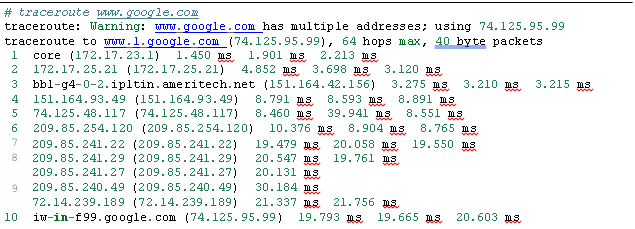- /
- /
- /
Using traceroute
Traceroute is a useful tool for testing and verifying routes and multi-WAN functionality, among other uses. It shows each “hop” along the path a packet travels from one end to the other, along with the latency encountered in reaching that intermediate point. On AZTCO-FW software, a traceroute can be performed by navigating to Diagnostics > Traceroute, or by using traceroute at the command line. From clients running Windows, the program is available under the name tracert.
Every IP packet contains a time-to-live (TTL) value. When a router passes a packet, it decrements the TTL by one. When a router receives a packet with a TTL of 1 and the destination is not a locally attached network, the router returns an ICMP error message “Time-to-live exceeded” and drops the packet. This is to limit the impact of routing loops, which otherwise would cause each packet to loop indefinitely.
Traceroute uses this TTL to its advantage to map the path to a specific network destination. It starts by sending the first packet with a TTL of 1. The first router (usually the default gateway) will send back an ICMP time-to-live exceeded error. The time between sending the packet and receiving the ICMP error is the time displayed, listed along with the IP address that sent the error and its reverse DNS, if any. After sending three packets with a TTL of 1 and displaying their response times, it will increment the TTL to 2 and send three more packets, noting the same information for the second hop.
Traceroute increments the TTL and repeats the process until it reaches the specified destination, or exceeds the maximum number of hops. Traceroute functions slightly differently on Windows and Unix-like operating systems (BSD, Linux, Mac OS X, Unix, etc.). Windows uses ICMP echo request packets (pings) while Unix-like systems use UDP packets by default. ICMP and UDP are layer 4 protocols, and traceroute is done at layer 3, so the protocol used is largely irrelevant except when considering a policy routing configuration. Traceroute from Windows clients will be policy routed based on which rule permits ICMP echo requests, while Unix-like clients will be routed by the rule matching the UDP ports in use.
In this example, traceroute is used to view the route to www.google.com:

The output shows that it took 10 hops to get there, and the latency generally increased with each hop, which is expected.
Note: When utilizing policy routing, such as with Multi-WAN, the firewall itself may not appear as a hop in traceroute. When policy routing is employed, pf does not decrement the TTL when forwarding packets, so traceroute cannot detect it as an intermediate router.
